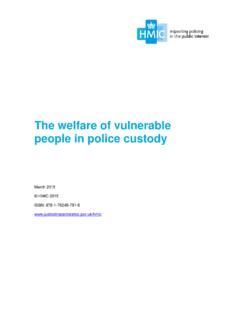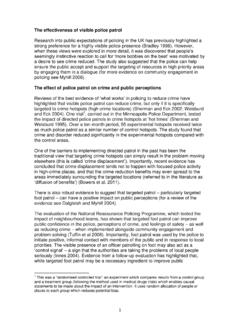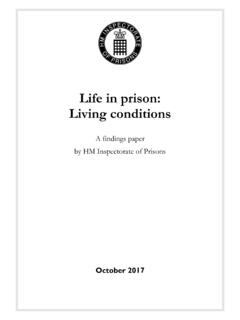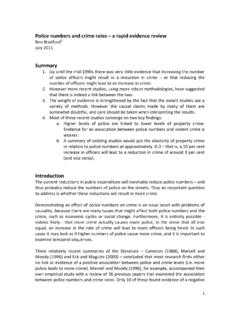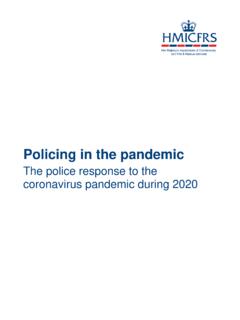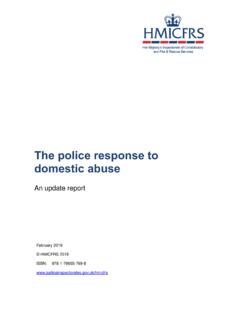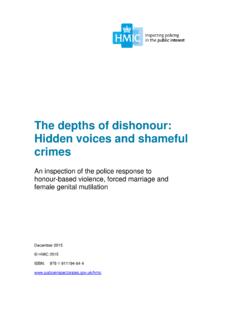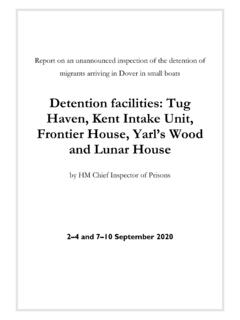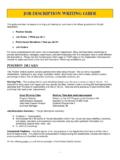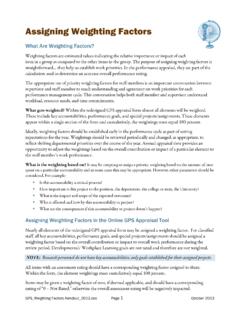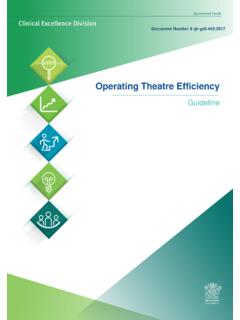Transcription of Key findings from the self audits of NHS organisations ...
1 The Victoria Climbi Inquiry reportKey findings from the self audits of NHS organisations ,social services departments and police forcesActing Chief Inspector of Social ServicesHer Majesty s Chief Inspector of ConstabularyActing Chief Executive, Commission for Health Improvement The Victoria Climbi Inquiry reportKey findings from the self audits of NHS organisations ,social services departments and police forcesContents1 Introduction32 Managing individual cases43 organisations arrangements for child protection64 Joint working85 Staff management and training106 Looking to the future12 Victoria Adjo Climbi died in the intensive care unit at St Mary s Hospital Paddingtonon 25 February 2000. She was eight years old. Victoria had suffered months ofappalling ill treatment by her great aunt Marie-Therese Kouao and Carl JohnManning.
2 Both were later sentenced to life imprisonment. Victoria s untimely death was not the first in such circumstances. The Secretary of State for Health and the Home Secretary, therefore, appointed Lord Laming to conduct an inquiry into the circumstances surrounding Victoria s death and torecommend action to improve child protection in England. The Victoria Climbi Inquiry report was published in January 2003. Lord Laming was particularly concerned about the low priority given to childprotection by the agencies involved with Victoria and strongly criticised people in senior positions who denied their own responsibility. Many of the 108recommendations in his report aimed to improve accountability for child protection. Many were also concerned with basic good Secretaries of State sent checklists of the relevant practice recommendationsto all 625 NHS organisations and 150 councils with social services responsibilities in England, and to all 43 police forces in England and Wales.
3 The Commission forHealth Improvement (CHI), Her Majesty s Inspectorate of Constabulary (HMIC) andthe Social Services Inspectorate (SSI) were asked to audit the implementation ofthese recommendations. All of the organisations concerned completed self results represent the first large scale audit of child protection arrangements. CHI, HMIC and SSI each produced a report on the findings of the audits which they presented to ministers in relevant departments. This is a report of joint key findings from the three inspectorates. It will bedistributed to all relevant agencies, so that they can consider the implications and learn the lessons from the Victoria Climbi Inquiry. 1 IntroductionKEY findings FROM THE SELF AUDITS34 Lord Laming made many recommendations about the handling of individual cases where neglect or abuse are suspected.
4 Particular concerns were: obtainingand recording relevant information about the child; referral and communicationbetween different agencies; carrying out prompt and effective assessment andinvestigations; and timely recording and auditing of decisions and audits found examples of arrangements for managing individual cases that appear to work well, including:the use of innovative systems by some NHS organisations for accessinginformation about a child and for flagging up concerns common referral arrangements in many cases, agreed through the Area ChildProtection Committee. However, the extent to which they are monitored varies the use of common paperwork and consistent use of the Framework for theAssessment of Children in Need and their Families between agencies in anumber of areasWe were concerned to note, however, that:some NHS organisations have only limited access to the child protection register and to previous case notes referral may not always happen as quickly as it should.
5 Only a third of councilssay they normally receive written confirmation of referrals within 48 hours. Police forces currently have little way of knowing if concerns are reportedimmediately by social services where a criminal offence is suspected, although all social services say this usually happenssocial services report variations in the effectiveness of discharge arrangementsfrom hospitals in child protection cases. Procedures for discharging children inneed may need strengthening. There were also concerns about arrangements for children in hospitals outside the social services area in which they live2 Managing individual casesKEY findings FROM THE SELF audits there may be an over reliance in some areas on the use of police protectionpowers, which may not always be in the best interests of children. Some policeforces have not issued updated guidance on police protection powers tooperational staffcommunication with children is not always a priority.
6 Access to interpretingservices for children whose first language is not English varies. Some councils donot include children s views and wishes in assessments as a matter of course there is a high level of unallocated child protection cases in a few social services departments the majority of police forces have issued guidance on investigations involvingchild victims. These should be dealt with promptly, efficiently and to the samestandard as cases involving adult victims. However, guidance mostly relates tointra familial abuse rather than extra familial abuse, which is mainly dealt withoutside child protection units. There is little auditing of allegations involving child victimswhere the police and social services carry out joint investigations, supervisorystaff involvement is sometimes affected by capacity. A few councils reportproblems with not having enough qualified staff to carry out enquiries involvingjoint interviewingrecord keeping needs improvement generally.
7 Common problems in the NHSinclude timeliness, variable quality and lack of monitoring. Social services need to record and monitor decision making by staff and managersKEY findings FROM THE SELF AUDITS56 The audits showed that there were positive things happening in relation to childprotection arrangements. In particular:there are dedicated and professional people throughout the audited services who give priority to protecting childrenpolicies, procedures and staff guidance for child protection generally existthroughout the NHS, social services and the police. There are, however, some exceptions there are many examples of action plans for improvement in child protectionservices stimulated by the Victoria Climbi Inquiry. In some cases, partnerorganisations have collaborated to draw up a joint action planthe audits themselves appear to have raised the profile of child protection in allorganisations, especially at senior levels, including non executive directors andcouncillors.
8 There is evidence of organisations carrying out detailed work andinvolving staff at all levels in the auditsHowever, we are concerned to note that there is too much variation in the servicesprovided by NHS organisations and that this potentially puts children at , SSI considered that 67 social services departments (45%) could not bejudged to be serving most or all children well. Particular aspects that need attention are: dedicated NHS children s units or police child protection units have a clear focuson child protection issues, but this focus is not always evident in parts of theorganisation that work primarily with adults there is a plethora of plans for children s services, both within and betweenagencies, some of which need to be better coordinated. These plans do notnecessarily include child protection as a priority systematic review of policies and procedures is sometimes lacking.
9 In addition,not all staff have seen, or have access to, child protection guidance, particularlyguidance produced by Area Child Protection Committees3 organisations arrangements for child protectionKEY findings FROM THE SELF AUDITSthe extent to which organisations monitor and audit compliance with policies and guidance varies considerably in the NHS, social services and the policethe lack of clarity about strategic health authorities and primary care trusts (PCTs) responsibilities for performance management in child protection. PCTs in particular need to increase their understanding of the responsibilities of independent contractors and to clarify their role in relation to themnot all NHS boards demonstrate sufficient awareness of, or responsibility for, child protection issues. In local government, the frequency and nature ofinformation provided to councillors about child protection cases or issues also varies considerably KEY findings FROM THE SELF AUDITS78 Improving cross agency working and communication was a particular concernarising from the Victoria Climbi Inquiry.
10 The audits reveal that organisations havemixed views about the effectiveness of cross agency and partnership the positive side:there are many references in the audits to working with a wide range of organisations in the public services and in the voluntary sectora range of fora exist, in addition to Area Child Protection Committees, to bring together senior management and professional staff of different well these fora interact is not always clear there are examples of joint working, including jointly funded posts, sharedlocations, coordinated training plans and shared training, and a few examples of joint monitoring of practiceArea Child Protection Committee guidance is generally widely (but notcomprehensively) disseminated among relevant local organisations . Social services departments often mention that there is an agreed process for revising this guidance there are examples of coordination of procedures across Area Child ProtectionCommittees where agencies cover several council areas, such as in LondonHowever, the audits also show that there are aspects of joint working that requiredevelopment, including.
